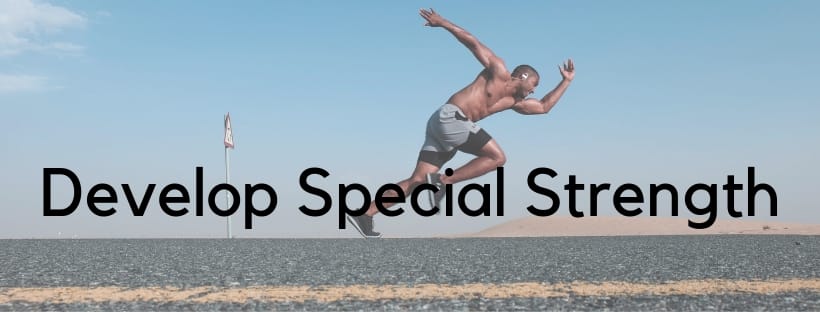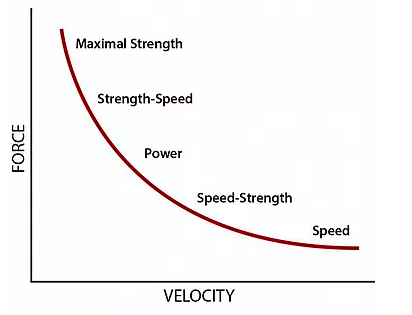We all know athletes need to develop and maintain a large base of physical fitness in order to be successful. As they progress in their training and lifting technique improves, the special strengths that are going to be developed get more specific. It is important to know that strengths are measured in time. When working with athletes, coaches need to understand what kind of strength they are training to know what physical skills need to be brought up and how to implement them through training.
The image below shows that difference in special strengths are measured in time. This can help us understand how an object of a certain mass moves through time. The x-axis shows velocity (speed of the movement) and the y-axis shows force (the amount of force in the ground). The higher the force, the slower the movement.
Maximal (Absolute Strength)
This trains the highest force, but the lowest velocity. In training, this is when an athlete would move a heavy weight, but would move very slow. HERE is an example of a one rep max back squat. Notice that the speed of the movement is slow, but do to the weight on the bar, the force is high. To exert high force, there needs to be high load. This is the best method to improve intra- and inter-muscular coordination (Louie Simmons, 2005).
Strength-Speed
Strength-Speed will be a relatively heavy load moved as quickly as possible, leaning toward strength rather than speed, but is done in a shorter time frame than maximal strength. The following shows two different movements, a power clean and a deadlift. However, it is not the movement itself, but the speed of the bar that is what should be noticed. Both movements are lighter than the maximal strength movement, but have much more speed.
Speed-Strength
The movements trained in this speed range are going to lean more toward speed than strength. Some examples of exercises in this speed range would be weighted jumps or medicine ball throws. There are many varieties to choose. The number of jumps will depend on the age, ability, and strength of the athlete.
Speed
This is the maximal velocity an individual can produce. In other words, high velocity low force (relative to absolute strength). Examples of this are bounding, rebounding plyometrics, or sprinting. Notice the spring, or rebound, which is the distinct difference in the spring or speed of the plyometric. This develops reactive strength (Verkhoshansky, 1986).
This is by no means a comprehensive guide to the way we train athletes, but I hope this shows how manipulating velocity and mass used through training can develop lagging areas of strength. You can think about strength in terms of speed and you now have some visuals as to how certain intensities may be targeted, changed, and emphasized based on the athlete’s strengths and weaknesses. Developing these different speeds or “special strengths” is a lot like having gears to a car and depending on the athlete, sport, or sport position (after a base and proper technique has been developed) different areas should be prioritized.
Whether you are someone looking for a good base of general physical preparedness or a student athlete looking to compete at the next level, we can help you reach your goals with our sound programming and expert coaching. Click below to schedule your free intro!



